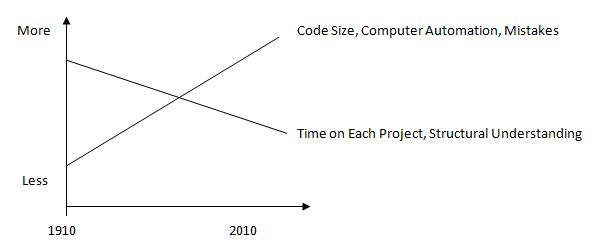Codes are good and extremely important, but they are getting completely out of control and unsustainable. There is an old Faraday adage:
Make every effort to ensure that the results of your experiment are proportional to the evidence and assumptions that produced them.
I remember listening to a great lecture by Ronald Hamburger regarding this same topic at an AISC conference. He used the example of a provision in the ASCE 7-10 code regarding how QCQ methods should be employed when combining model results where translational and torsional modes are intermixed. While admitting not knowing what this meant himself (and for Mr. Hamburger, that is saying something) and how to go about determining if in fact QCQ-4 should be used, he discussed whether the provision was actually important. He questioned the code provision, something we all need to do. This also helps us understand them better. The questions we may ask in this case are:
- “Why do I care about exact modal superposition methods when I am doing Response Spectrum Analysis, which is exceedingly approximate?”
- “Do I really need to be exact when I just took my elastic response spectrum and divided by 500% (R=5 for example)?”
Of course not (should be the answer to question 2).
The code committees should keep in mind the approximate nature of this enterprise called structural engineering. Not only are there large uncertainties in our loads and material strengths used in design, there are huge uncertainties in construction. Before meeting in a conference room, the code committee members should visit a construction site to remember how reinforcing is placed within a slab on grade. While they are there, they can see what a true pinned base support looks like (a thick base plate with four heavy anchors). They can see the soil and the assumptions used for designing the footings. They can see what shear connections look like that are not supposed to transfer moment. They will notice the large non-structural interior and exterior walls that were completely neglected when modeling the stiffness of the structure.
In summary, the code committee should ask themselves the following two questions:
- Is this provision important to the design of safe structures?
- Is the provision too exact?
In other words (from Faraday) "is the proposed provision proportional to the assumptions and uncertainty inherent in structural design (loads, strengths, construction, etc)?” If they asked these questions, the codes would not balloon to the size they are now.
 Codes are getting so large they are becoming impossible to meet. This is also going to hurt the profession. We need to reduce code provisions and in their place, increase design guides to continue producing the state of the art. Should we stop updating codes? No. Should we slow down? Yes, absolutely. The updates to the codes are out of control and unsustainable. My ASCE 7 is a half inch thicker and depressing. I am now a voting member of ASCE-7 and will fight every provision that does not meet these simple requirements.
Codes are getting so large they are becoming impossible to meet. This is also going to hurt the profession. We need to reduce code provisions and in their place, increase design guides to continue producing the state of the art. Should we stop updating codes? No. Should we slow down? Yes, absolutely. The updates to the codes are out of control and unsustainable. My ASCE 7 is a half inch thicker and depressing. I am now a voting member of ASCE-7 and will fight every provision that does not meet these simple requirements.
Codes already contribute to the need for fully automated applied science because no one would be able to apply the amount of code information to a particular problem. What does automation foster? Non-thinkers. I understand the codes are becoming more and more sophisticated and provisions are being improved to better mimic reality - but there was a time when people understood that code requirements needed to exist to ensure public safety, and that was the standard that they needed to meet. That should be the only standard. I like to compare my ACI 318-63 (no, I am not that old, I am an asshole who bought an old code to compare) with my ACI 318-11 just to remember which provisions are actually very important and how to prioritize my reading. We need to join code committees and take our profession back - join me on the ASCE-7 committee or other important committees!
We will never be able to mimic the complexities of nature (the real world) in our computer models. Our professor's are trying and great work is being done. This great work may lead to larger codes and more accurate requirements at modeling and designing structures. Some of this is good and some of this is harmful. Larger codes means less understanding and more reliance on software to be code compliant, which leads to less understanding, less interest, more errors, and, possibly, more lawsuits and more collapses. I don't believe the common wisdom that computers reduce error. Computers just hide more error.

